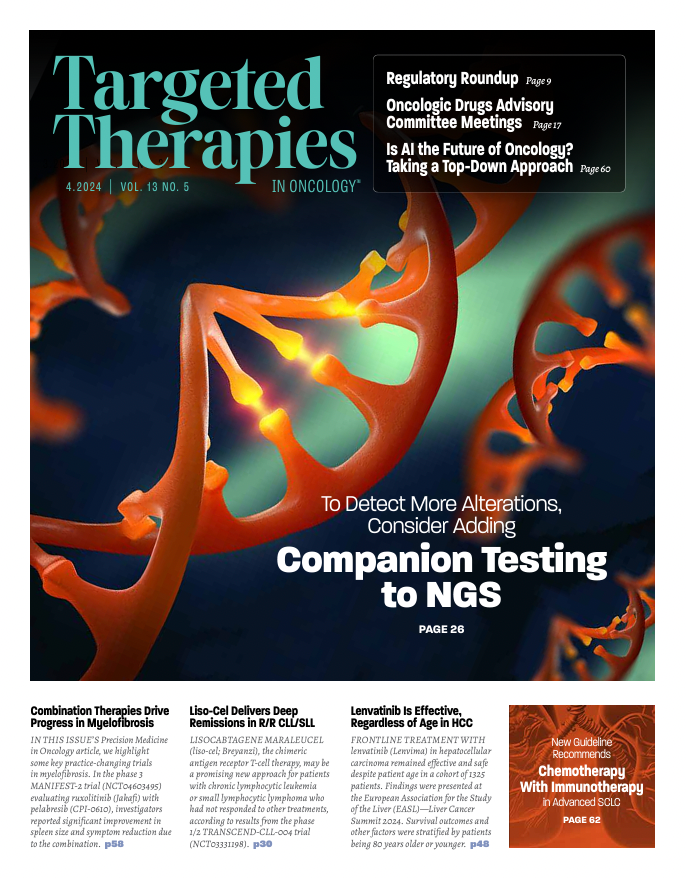Biomarker-Focused Strategies Improve Outcomes in Gynecologic Malignancies
Targeted therapies and immunotherapies across the ovarian, endometrial, and cervical cancers landscape play expanded roles, according to Ritu Salani, MD, MBA.
Ritu Salani, MD, MBA
Professor of Obstetrics and Gynecology
Director of the Division of Gynecologic Oncology
UCLA Health
Los Angeles, CA

As treatment for gynecologic malignancies focuses more on targeted therapies that use biomarker-focused strategies, a common challenge for clinicians is how best to sequence the available treatments. Targeted therapies and immunotherapies across the ovarian, endometrial, and cervical cancers landscape play expanded roles. Ritu Salani, MD, MBA, cochair of the 15th Annual International Symposium on Ovarian Cancer and Other Gynecologic Malignancies™, sponsored by Physicians’ Education Resource® (PER®), LLC, anticipates many of the conversations among faculty and attendees will focus on new targeted therapies in ovarian cancer, as well as the optimal use of immunotherapy in endometrial and cervical cancer (AGENDA).
“How do we sequence these therapies? Which patients will benefit from up-front therapies and how does locally advanced disease vs advanced stage cancer affect treatment?” Salani told Targeted Therapies in Oncology during an interview prior to the meeting. “I think understanding some of the nuances about the timing of immunotherapy is going to be very interesting,” added Salani, professor of obstetrics and gynecology and director, Division of Gynecologic Oncology, at UCLA Health in Los Angeles, California. Cochairing the conference along with Salani is Kathleen Moore, MD, MS, who is professor, Section of Gynecologic Oncology, University of Oklahoma College of Medicine; associate director of clinical research, Stephenson Cancer Center; and director, Oklahoma TSET Phase I Program, University of Oklahoma Health Sciences, in Oklahoma City.

Endometrial Cancer
In 2023, 2 immunotherapy trials in endometrial cancer showed improvements in progression-free survival (PFS) in certain patient subgroups.
Findings from the phase 3 NRG-GY018 trial (NCT03914612) demonstrated that adding pembrolizumab (Keytruda) to standard chemotherapy led to significantly longer PFS rates vs chemotherapy alone among patients with advanced or recurrent endometrial cancer.1 The current standard of treatment in this population is paclitaxel plus carboplatin.
The trial, which assessed the potential benefit of adding pembrolizumab, evaluated 816 patients with measurable disease (stage III or IVA) or stage IVB or recurrent endometrial cancer. Patients were randomly assigned to receive either pembrolizumab or placebo along with combination therapy with paclitaxel plus carboplatin. The immunotherapy or placebo was administered in 6 cycles every 3 weeks, followed by 14 maintenance cycles every 6 weeks.
After a 12-month follow-up, Kaplan-Meier estimates of PFS in the mismatch repair–deficient (dMMR) cohort (n = 225) were 74% among those given pembrolizumab and 38% for those treated with placebo (HR, 0.30; 95% CI, 0.19-0.48; P < .001), a 70% difference in relative risk. In the mismatch repair–proficient (pMMR) cohort (n = 588), the median PFS was 13.1 months with pembrolizumab and 8.7 months with placebo (HR, 0.54; 95% CI, 0.41-0.71; P < .001).1
Overall, both cohorts showed that the addition of pembrolizumab to chemotherapy significantly improved PFS and no unexpected adverse events (AEs) occurred. Further studies plan to assess the combination to determine whether it is more efficacious than pembrolizumab alone in this patient population.
The phase 3 RUBY trial (NCT03981796) combined dostarlimab (Jemperli) and carboplatin and paclitaxel in patients with primary advanced stage III or IV or first recurrent endometrial cancer.2 RUBY consisted of 4 arms: 2 active comparators and 2 placebo comparators. In the first arm, patients received dostarlimab plus carboplatin and paclitaxel followed by dostarlimab. In the second arm, patients received dostarlimab and carboplatin and paclitaxel followed by dostarlimab and niraparib (Zejula). Both placebo comparator arms received placebo and carboplatin and paclitaxel followed by placebo.
The primary end point was PFS in 2 prespecified subpopulations: dMMR/microsatellite instability–high (MSI-H) and pMMR/ microsatellite stable. The dMMR/MSI-H and overall patient populations had 72% (HR, 0.28; 95% CI, 0.16-0.50) and 36% (HR, 0.64; 95% CI, 0.51-0.80) reductions in risk of disease progression or death, respectively.2
Secondary end points include PFS, objective response rate (ORR), duration of response by BICR and investigator assessment, quality-of-life measures, and ECOG performance status scores.2
“In light of these findings and looking at subgroup analyses, how do we stratify these patients?” asked Salani. “I’m most keen on exploring the new approaches in these settings.”
Ovarian Cancer
In ovarian cancer, new antibody-drug conjugates, which combine monoclonal antibodies with cytotoxic chemotherapy drugs, target 2 biomarkers—folate receptor alpha (FRα) and human sodium-dependent phosphate transport protein 2B (NaPi2b).
Mirvetuximab soravtansine-gynx (Elahere) has shown improvement in PFS, ORR, and overall survival, according to 2 subset analyses of the phase 3 MIRASOL study (NCT04209855), which is evaluating mirvetuximab soravtansine compared with chemotherapy for the treatment of patients with FRα-positive platinum-resistant ovarian cancer (PROC).3 The FDA granted approval to mirvetuximab soravtansine in November 2022 for the treatment of patients with FRα-positive PROC who had received 1 to 3 previous lines of treatment.4
“[Findings] clearly showed that this was better than physician choice chemotherapy, although there were some different options selected,” Salani said. “This provides a nice option for patients with a favorable toxicity profile and can maintain a good quality of life for patients while providing them survival benefit over some of the standard options we use,” Salani added.
In contrast, in topline results from the phase 1b/2 UPLIFT trial (NCT03319628), 22 of 141 NaPi2b-positive patients responded for an investigator-assessed ORR of 15.6% (95% CI, 10.0%-22.7%) when receiving upifitamab rilsodotin (UpRi), which targets NaPi2b. The median duration of response (DOR) in this population was 7.4 months.5
As of the data cutoff on May 31, 2023, UPLIFT enrolled 268 patients, 141 of whom were NaPi2b-positive, which was defined as having a tumor proportion score of at least 75%.5 Patients had platinum-resistant ovarian cancer and had received a median of 3 prior lines of therapy, with 31% having received 4 prior lines.
These included bevacizumab (Avastin) in 84% and PARP inhibitor in 69%. Patients received 36 mg/m2 UpRi up to a maximum dose of approximately 80 mg every 4 weeks.6 The primary end point was investigator-assessed ORR in the NaPi2b- positive patients, with secondary end points including investigator-assessed ORR in all patients, ORR by independent radiological review, DOR, and safety.
Cervical Cancer
During the European Society for Medical Oncology Congress 2023, findings from the phase 3 innovaTV 301 trial (NCT04697628)7 showed that patients treated with tisotumab vedotin experienced a 30% decreased risk of death vs those treated with the traditional chemotherapy.
Similar changes were observed in PFS rates, with a 33% decrease in PFS. Response rates were about 3 to 4 times higher in the tisotumab vedotin arm vs chemotherapy.
“In cervical cancer, we’ve been seeing a de-escalation of surgical intervention,” Salani said. “Performing a simple hysterectomy may be more appropriate than performing a radical hysterectomy, which has an increased morbidity,” she continued.
Salani said it represents an important change with a focus on offering the best therapy to patients without compromising oncologic outcomes.
REFERENCES:
1. Eskander RN, Sill MW, Beffa L, et al. Pembrolizumab plus chemotherapy in advanced endometrial cancer. N Engl J Med. 2023;388(23):2159-2170. doi:10.1056/NEJMoa2302312
2. Mirza MR, Chase DM, Slomovitz BM, et al. Dostarlimab for Primary Advanced or Recurrent Endometrial Cancer. N Engl J Med. 2023;388(23):2145-2158. doi:10.1056/NEJMoa2216334
3. Moore KN, Angelergues A, Konecny GE, et al. Phase III MIRASOL (GOG 3045/ENGOT-ov55) study: Initial report of mirvetuximab soravtansine vs. investigator's choice of chemotherapy in platinum-resistant, advanced high-grade epithelial ovarian, primary peritoneal, or fallopian tube
cancers with high folate receptor-alpha expression. J Clin Oncol. 2023;41(suppl 17):LBA5507. doi:10.1200/JCO.2023.41.17_suppl.LBA5507
4. ImmunoGen announces FDA accelerated approval of Elahere™ (mirvetuximab soravtansine-gynx) for the treatment of platinum-resistant ovarian cancer. News release. November 14, 2022. Accessed November 14, 2022. https://bit.ly/3O61Flg
5. Mersana Therapeutics announces topline data from UPLIFT clinical trial in patients with platinum-resistant ovarian cancer and strategic reprioritization. News release. Mersana Therapeutics. July 27, 2023. Accessed August 1, 2023. https://tinyurl.com/2p9y83f9
6. Richardson D, Hamilton E, Barve M, et al. Updated results from the phase 1 expansion study of upifitamab rilsodotin (UpRi; XMT-1536), a NaPi2b-directed dolaflexin antibody drug conjugate (ADC) in ovarian cancer (076). Gyn Oncol. 2021;166(suppl 1):S48. doi:10.1016/S0090-
8258(22)01294-X
7. Vergote IB, Gonzalez Martin A, Fujiwara K, et al. innovaTV 301/ENGOT-cx12/GOG-3057: A global, randomized, open-label, phase III study of tisotumab vedotin vs investigator’s choice of chemotherapy in 2L or 3L recurrent or metastatic cervical cancer. Ann Oncol. 2023;34(suppl
2):S1276-S1277. doi:10.1016/j.annonc.2023.10.029

Leon-Ferre Explores Targeting of PIK3CA Alterations in ER+ Breast Cancer
July 24th 2024During a live Community Case Forum event in partnership with the Minnesota Society of Clinical Oncology, Roberto A. Leon-Ferre, MD, discussed drugs targeting PIK3CA alterations in patients with ER+ metastatic breast cancer.
Read More
Roundtable Roundup: Treatment for Metastatic pMMR Endometrial Cancer
July 23rd 2024In separate, live virtual events, Michael J. Birrer, MD, PhD, and Jubilee Brown, MD, surveyed participants on the treatment of a postmenopausal woman with stage IVA endometrial cancer after first-line chemotherapy.
Read More
Tisotumab Vedotin Continues to Show Survival Benefits in Recurrent Cervical Cancer
July 22nd 2024An analysis from the innovaTV 301 showed that tisotumab vedotin in the second- and third-line bettered overall survival vs investigator’s choice of chemotherapy in patients with cervical cancer.
Read More